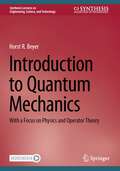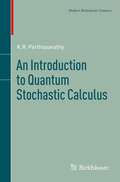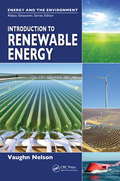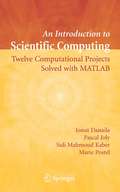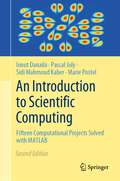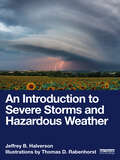- Table View
- List View
Introduction to Quantum Groups (Modern Birkhäuser Classics Ser.)
by George LusztigThe quantum groups discussed in this book are the quantized enveloping algebras introduced by Drinfeld and Jimbo in 1985, or variations thereof. The theory of quantum groups has led to a new, extremely rigid structure, in which the objects of the theory are provided with canonical basis with rather remarkable properties. This book will be of interest to mathematicians working in the representation theory of Lie groups and Lie algebras, knot theorists and to theoretical physicists and graduate students. Since large parts of the book are independent of the theory of perverse sheaves, the book could also be used as a text book.
Introduction to Quantum Information Science (Graduate Texts in Physics)
by Masahito Hayashi Satoshi Ishizaka Akinori Kawachi Gen Kimura Tomohiro OgawaThis book presents the basics of quantum information, e.g., foundation of quantum theory, quantum algorithms, quantum entanglement, quantum entropies, quantum coding, quantum error correction and quantum cryptography. The required knowledge is only elementary calculus and linear algebra. This way the book can be understood by undergraduate students. In order to study quantum information, one usually has to study the foundation of quantum theory. This book describes it from more an operational viewpoint which is suitable for quantum information while traditional textbooks of quantum theory lack this viewpoint. The current book bases on Shor's algorithm, Grover's algorithm, Deutsch-Jozsa's algorithm as basic algorithms. To treat several topics in quantum information, this book covers several kinds of information quantities in quantum systems including von Neumann entropy. The limits of several kinds of quantum information processing are given. As important quantum protocols, this book contains quantum teleportation, quantum dense coding, quantum data compression. In particular conversion theory of entanglement via local operation and classical communication are treated too. This theory provides the quantification of entanglement, which coincides with von Neumann entropy. The next part treats the quantum hypothesis testing. The decision problem of two candidates of the unknown state are given. The asymptotic performance of this problem is characterized by information quantities. Using this result, the optimal performance of classical information transmission via noisy quantum channel is derived. Quantum information transmission via noisy quantum channel by quantum error correction are discussed too. Based on this topic, the secure quantum communication is explained. In particular, the quantification of quantum security which has not been treated in existing book is explained. This book treats quantum cryptography from a more practical viewpoint.
Introduction to Quantum Mechanics: With a Focus on Physics and Operator Theory (Synthesis Lectures on Engineering, Science, and Technology)
by Horst R. BeyerThis book presents an introduction to quantum mechanics that consistently uses the methods of operator theory, allowing readers to develop a physical understanding of quantum mechanical systems. The methods of operator theory are discussed throughout the book and presented with a mathematically rigorous approach. The author describes in detail how to use the methods of operator theory for analyzing quantum mechanical systems, starting with the definition of the involved physical operators (observables) up to the calculation of their spectra, spectral measures, and functional calculus. In addition, the book includes the construction of exponential functions of the involved Hamilton operators that solve the problem of time evolution.
An Introduction to Quantum Stochastic Calculus (Modern Birkhäuser Classics)
by K.R. ParthasarathyAn Introduction to Quantum Stochastic Calculus aims to deepen our understanding of the dynamics of systems subject to the laws of chance both from the classical and the quantum points of view and stimulate further research in their unification. This is probably the first systematic attempt to weave classical probability theory into the quantum framework and provides a wealth of interesting features: The origin of Ito’s correction formulae for Brownian motion and the Poisson process can be traced to commutation relations or, equivalently, the uncertainty principle.Quantum stochastic integration enables the possibility of seeing new relationships between fermion and boson fields.Many quantum dynamical semigroups as well as classical Markov semigroups are realised through unitary operator evolutions. The text is almost self-contained and requires only an elementary knowledge of operator theory and probability theory at the graduate level. - - - This is an excellent volume which will be a valuable companion both to those who are already active in the field and those who are new to it. Furthermore there are a large number of stimulating exercises scattered through the text which will be invaluable to students. (Mathematical Reviews) This monograph gives a systematic and self-contained introduction to the Fock space quantum stochastic calculus in its basic form (...) by making emphasis on the mathematical aspects of quantum formalism and its connections with classical probability and by extensive presentation of carefully selected functional analytic material. This makes the book very convenient for a reader with the probability-theoretic orientation, wishing to make acquaintance with wonders of the noncommutative probability, and, more specifcally, for a mathematics student studying this field. (Zentralblatt MATH)Elegantly written, with obvious appreciation for fine points of higher mathematics (...) most notable is [the] author's effort to weave classical probability theory into [a] quantum framework.(The American Mathematical Monthly)
Introduction to Random Matrices: Theory and Practice (SpringerBriefs in Mathematical Physics #26)
by Giacomo Livan Marcel Novaes Pierpaolo VivoModern developments of Random Matrix Theory as well as pedagogical approaches to the standard core of the discipline are surprisingly hard to find in a well-organized, readable and user-friendly fashion. This slim and agile book, written in a pedagogical and hands-on style, without sacrificing formal rigor fills this gap. It brings Ph.D. students in Physics, as well as more senior practitioners, through the standard tools and results on random matrices, with an eye on most recent developments that are not usually covered in introductory texts. The focus is mainly on random matrices with real spectrum.The main guiding threads throughout the book are the Gaussian Ensembles. In particular, Wigner’s semicircle law is derived multiple times to illustrate several techniques (e.g., Coulomb gas approach, replica theory).Most chapters are accompanied by Matlab codes (stored in an online repository) to guide readers through the numerical check of most analytical results.
An Introduction to Recent Developments in Theory and Numerics for Conservation Laws: Proceedings of the International School on Theory and Numerics for Conservation Laws, Freiburg/Littenweiler, October 20–24, 1997 (Lecture Notes in Computational Science and Engineering #5)
by Dietmar Kröner Mario Ohlberger Christian RohdeIntroduction to Relativistic Continuum Mechanics (Lecture Notes in Physics #727)
by Giorgio Ferrarese Donato BiniThis mathematically-oriented introduction takes the point of view that students should become familiar, at an early stage, with the physics of relativistic continua and thermodynamics within the framework of special relativity. Therefore, in addition to standard textbook topics such as relativistic kinematics and vacuum electrodynamics, the reader will be thoroughly introduced to relativistic continuum and fluid mechanics. There is emphasis on the 3+1 splitting technique.
An Introduction to Relativistic Processes and the Standard Model of Electroweak Interactions (UNITEXT for Physics)
by Carlo M. Becchi Giovanni RidolfiThis book offers a self-contained introduction to the theory of electroweak interactions based on the semi-classical approach to relativistic quantum field theory, with thorough discussion of key aspects of the field. The basic tools for the calculation of cross sections and decay rates in the context of relativistic quantum field theory are reviewed in a short, but complete and rigorous, presentation. Special attention is focused on relativistic scattering theory and on calculation of amplitude in the semi-classical approximation. The central part of the book is devoted to an illustration of the unified field theory of electromagnetic and weak interactions as a quantum field theory with spontaneously broken gauge invariance; particular emphasis is placed on experimental confirmations of the theory. The closing chapters address the most recent developments in electroweak phenomenology and provide an introduction to the theory and phenomenology of neutrino oscillations. In this 2nd edition the discussion of relativistic scattering processes in the semi-classical approximation has been revised and as a result intermediate results are now explicitly proven. Furthermore, the recent discovery of the Higgs boson is now taken into account throughout the book. In particular, the Higgs decay channel into a pair of photons, which has played a crucial role in the discovery, is discussed.As in the first edition, the accent is still on the semi-classical approximation. However, in view of the necessity of a discussion of H !, the authors give several indications about corrections to the semiclassical approximation. Violation of unitarity is discussed in more detail, including the dispersion relations as a tool for computing loop corrections; the above-mentioned Higgs decay channel is illustrated by means of a full one-loop calculation; and finally, loop effects on the production of unstable particles (such as the Z0 boson) are now discussed. Finally, the neutrino mass and oscillation analysis is updated taking into account the major achievements of the last years.
Introduction to Renewable Energy
by Vaughn C. NelsonAs the world population grows and places more demand on limited fossil fuels, renewable energy becomes more relevant as part of the solution to the impending energy dilemma. Renewable energy is now included in national policies, with goals for it to be a significant percentage of generated energy within the coming decades. A comprehensive overview,
An Introduction to Riemann Surfaces, Algebraic Curves and Moduli Spaces (Theoretical and Mathematical Physics)
by Martin SchlichenmaierThis book gives an introduction to modern geometry. Starting from an elementary level, the author develops deep geometrical concepts that play an important role in contemporary theoretical physics, presenting various techniques and viewpoints along the way. This second edition contains two additional, more advanced geometric techniques: the modern language and modern view of Algebraic Geometry and Mirror Symmetry.
An Introduction to Riemannian Geometry: With Applications to Mechanics and Relativity (Universitext)
by Leonor Godinho José NatárioUnlike many other texts on differential geometry, this textbook also offers interesting applications to geometric mechanics and general relativity.The first part is a concise and self-contained introduction to the basics of manifolds, differential forms, metrics and curvature. The second part studies applications to mechanics and relativity including the proofs of the Hawking and Penrose singularity theorems. It can be independently used for one-semester courses in either of these subjects.The main ideas are illustrated and further developed by numerous examples and over 300 exercises. Detailed solutions are provided for many of these exercises, making An Introduction to Riemannian Geometry ideal for self-study.
Introduction to Risk and Uncertainty in Hydrosystem Engineering (Topics in Safety, Risk, Reliability and Quality)
by Ehsan Goodarzi Mina Ziaei Lee Teang ShuiWater engineers require knowledge of stochastic, frequency concepts, uncertainty analysis, risk assessment, and the processes that predict unexpected events.This book presents the basics of stochastic, risk and uncertainty analysis, and random sampling techniques in conjunction with straightforward examples which are solved step by step. In addition, appropriate Excel functions are included as an alternative to solve the examples, and two real case studies is presented in the last chapters of book.
Introduction to Rural Planning: Economies, Communities and Landscapes
by Nick Gallent Iqbal Hamiduddin Meri Juntti Sue Kidd Dave ShawIntroduction to Rural Planning: Economies, Communities and Landscapes provides a critical analysis of the key challenges facing rural places and the ways that public policy and community action shape rural spaces.? The second edition provides an examination of the composite nature of ‘rural planning’, which combines land-use and spatial planning elements with community action, countryside management and the projects and programmes of national and supra-national agencies and organisations. It also offers a broad analysis of entrepreneurial social action as a shaper of rural outcomes, with particular coverage of the localism agenda and Neighbourhood Planning in England. With a focus on accessibility and rural transport provision, this book examines the governance arrangements needed to deliver integrated solutions spanning urban and rural places. Through an examination of the ecosystem approach to environmental planning, it links the procurement of ecosystem services to the global challenges of habitat degradation and loss, climate change and resource scarcity and management. A valuable resource for students of planning, rural development and rural geography, Introduction to Rural Planning aims to make sense of current rural challenges and planning approaches, evaluating the currency of the ‘rural’ label in the context of global urbanisation, arguing that rural spaces are relational spaces characterised by critical production and consumption tensions.?
Introduction to Rural Planning: Economies, Communities and Landscapes
by Nick Gallent Iqbal Hamiduddin Meri Juntti Sue Kidd Dave ShawIntroduction to Rural Planning: Economies, Communities and Landscapes provides a critical analysis of the key challenges facing rural places and the ways that public policy and community action shape rural spaces.? The second edition provides an examination of the composite nature of ‘rural planning’, which combines land-use and spatial planning elements with community action, countryside management and the projects and programmes of national and supra-national agencies and organisations. It also offers a broad analysis of entrepreneurial social action as a shaper of rural outcomes, with particular coverage of the localism agenda and Neighbourhood Planning in England. With a focus on accessibility and rural transport provision, this book examines the governance arrangements needed to deliver integrated solutions spanning urban and rural places. Through an examination of the ecosystem approach to environmental planning, it links the procurement of ecosystem services to the global challenges of habitat degradation and loss, climate change and resource scarcity and management. A valuable resource for students of planning, rural development and rural geography, Introduction to Rural Planning aims to make sense of current rural challenges and planning approaches, evaluating the currency of the ‘rural’ label in the context of global urbanisation, arguing that rural spaces are relational spaces characterised by critical production and consumption tensions.?
An Introduction to Saline Lakes on the Qinghai—Tibet Plateau (Monographiae Biologicae #76)
by Zheng MianpingSince 1956 the author has been making extensive and detailed investigations of saline lakes on the Qinghai-Tibet plateau. On the basis of large amounts of reliable first-hand data and multidisciplinary analysis, the book deals with the temporal-spatial evolution of the plateau saline lakes and the prospects for inorganic salts and organic resources and their exploitation and protection, as well as the relationships between saline lakes and global changes. This book is the first English monograph on saline lakes on the Qinghai-Tibet Plateau - the `Roof of the World'. Compared with books about saline lakes in other areas of the world, this monograph is written in a multidisciplinary, comprehensive and systematic way. It may be used by graduate students, teachers, researchers, field geologists and engineers as a reference book in research, teaching, etc.
Introduction to satellite oceanography (Remote Sensing of Earth Resources and Environment #3)
by G.A. MaulSatelli te oceanography, as the term is used in this book, is a generic term that means application of the technology of aerospace electromagnetic remote sensing to the study of the oceans. The key words here are "application of technology ••. to the study of the oceans." The goal is to learn more about our planet's hydrosphere. As such, remote sensing technology is another tool in the oceanographer's sea bag, just like a bathythermograph or a plankton net. But is a whole book necessary if remote sensing is just another tool? While it is true that no one has written a whole book on plankton nets, volumes have been written about what is found in those nets. Today's state-of-the-art measurements from spacecraft or aircraft first must be interpreted in terms of their physics; then the interpretations must be understood in terms of oceanic processes. This is not materially different from the analogy to Ii plankton net; marine biolo gists still argue about what didn't get caught in the net.
An Introduction to Scientific Computing: Twelve Computational Projects Solved with MATLAB
by Ionut Danaila Pascal Joly Sidi Mahmoud Kaber Marie PostelThis book demonstrates scientific computing by presenting twelve computational projects in several disciplines including Fluid Mechanics, Thermal Science, Computer Aided Design, Signal Processing and more. Each follows typical steps of scientific computing, from physical and mathematical description, to numerical formulation and programming and critical discussion of results. The text teaches practical methods not usually available in basic textbooks: numerical checking of accuracy, choice of boundary conditions, effective solving of linear systems, comparison to exact solutions and more. The final section of each project contains the solutions to proposed exercises and guides the reader in using the MATLAB scripts available online.
An Introduction to Scientific Computing: Fifteen Computational Projects Solved with MATLAB
by Ionut Danaila Pascal Joly Sidi Mahmoud Kaber Marie PostelThis book demonstrates scientific computing by presenting twelve computational projects in several disciplines including Fluid Mechanics, Thermal Science, Computer Aided Design, Signal Processing and more. Each follows typical steps of scientific computing, from physical and mathematical description, to numerical formulation and programming and critical discussion of results. The text teaches practical methods not usually available in basic textbooks: numerical checking of accuracy, choice of boundary conditions, effective solving of linear systems, comparison to exact solutions and more. The final section of each project contains the solutions to proposed exercises and guides the reader in using the MATLAB scripts available online.
An Introduction to Seismology, Earthquakes, and Earth Structure
by Seth Stein Michael WysessionAn Introduction to Seismology, Earthquakes and Earth Structures is an introduction to seismology and its role in the earth sciences, and is written for advanced undergraduate and beginning graduate students. The fundamentals of seismic wave propagation are developed using a physical approach and then applied to show how refraction, reflection, and teleseismic techniques are used to study the structure and thus the composition and evolution of the earth. The book shows how seismic waves are used to study earthquakes and are integrated with other data to investigate the plate tectonic processes that cause earthquakes. Figures, examples, problems, and computer exercises teach students about seismology in a creative and intuitive manner. Necessary mathematical tools including vector and tensor analysis, matrix algebra, Fourier analysis, statistics of errors, signal processing, and data inversion are introduced with many relevant examples. The text also addresses the fundamentals of seismometry and applications of seismology to societal issues. Special attention is paid to help students visualize connections between different topics and view seismology as an integrated science. An Introduction to Seismology, Earthquakes, and Earth Structure gives an excellent overview for students of geophysics and tectonics, and provides a strong foundation for further studies in seismology. Multidisciplinary examples throughout the text - catering to students in varied disciplines (geology, mineralogy, petrology, physics, etc.). Most up to date book on the market - includes recent seismic events such as the 1999 Earthquakes in Turkey, Greece, and Taiwan). Chapter outlines - each chapter begins with an outline and a list of learning objectives to help students focus and study. Essential math review - an entire section reviews the essential math needed to understand seismology. This can be covered in class or left to students to review as needed. End of chapter problem sets - homework problems that cover the material presented in the chapter. Solutions to all odd numbered problem sets are listed in the back so that students can track their progress. Extensive References - classic references and more current references are listed at the end of each chapter. A set of instructor's resources containing downloadable versions of all the figures in the book, errata and answers to homework problems is available at: http://levee.wustl.edu/seismology/book/. Also available on this website are PowerPoint lecture slides corresponding to the first 5 chapters of the book.
An Introduction to Seismology, Earthquakes, and Earth Structure
by Seth Stein Michael WysessionAn Introduction to Seismology, Earthquakes and Earth Structures is an introduction to seismology and its role in the earth sciences, and is written for advanced undergraduate and beginning graduate students. The fundamentals of seismic wave propagation are developed using a physical approach and then applied to show how refraction, reflection, and teleseismic techniques are used to study the structure and thus the composition and evolution of the earth. The book shows how seismic waves are used to study earthquakes and are integrated with other data to investigate the plate tectonic processes that cause earthquakes. Figures, examples, problems, and computer exercises teach students about seismology in a creative and intuitive manner. Necessary mathematical tools including vector and tensor analysis, matrix algebra, Fourier analysis, statistics of errors, signal processing, and data inversion are introduced with many relevant examples. The text also addresses the fundamentals of seismometry and applications of seismology to societal issues. Special attention is paid to help students visualize connections between different topics and view seismology as an integrated science. An Introduction to Seismology, Earthquakes, and Earth Structure gives an excellent overview for students of geophysics and tectonics, and provides a strong foundation for further studies in seismology. Multidisciplinary examples throughout the text - catering to students in varied disciplines (geology, mineralogy, petrology, physics, etc.). Most up to date book on the market - includes recent seismic events such as the 1999 Earthquakes in Turkey, Greece, and Taiwan). Chapter outlines - each chapter begins with an outline and a list of learning objectives to help students focus and study. Essential math review - an entire section reviews the essential math needed to understand seismology. This can be covered in class or left to students to review as needed. End of chapter problem sets - homework problems that cover the material presented in the chapter. Solutions to all odd numbered problem sets are listed in the back so that students can track their progress. Extensive References - classic references and more current references are listed at the end of each chapter. A set of instructor's resources containing downloadable versions of all the figures in the book, errata and answers to homework problems is available at: http://levee.wustl.edu/seismology/book/. Also available on this website are PowerPoint lecture slides corresponding to the first 5 chapters of the book.
An Introduction to Severe Storms and Hazardous Weather
by Jeffrey B. HalversonThis book presents a deep and encompassing survey of severe weather in all its forms. An Introduction to Severe Storms and Hazardous Weather is an exciting new textbook that allows students to learn the principles of atmospheric science through the drama, exhilaration, and even tragedy of severe weather.Balancing breadth and depth, Jeffrey B. Halverson adeptly combines a short, accessible introduction to the basic principles of meteorology with detailed coverage on large- and small-scale weather hazards. He draws on specific up-to-date case studies from North America to illustrate the cause of meteorological events including hurricanes, heavy snow and ice, floods, and tornadoes. Unlike existing books on the market, Halverson delves deep into the societal impacts of these events, drawing on examples from agriculture, utility infrastructure, and commercial aviation. Each chapter also features high-quality, customized color artwork by Thomas D. Rabenhorst that helps to enhance and embed learning.Thorough in its scope, and written with an impeccable focus on the science, this book will be an essential resource for introductory undergraduate courses in severe weather, natural hazards, and extreme meteorology. It is also an excellent supplemental textbook for courses on meteorology and atmospheric science.
An Introduction to Severe Storms and Hazardous Weather
by Jeffrey B. HalversonThis book presents a deep and encompassing survey of severe weather in all its forms. An Introduction to Severe Storms and Hazardous Weather is an exciting new textbook that allows students to learn the principles of atmospheric science through the drama, exhilaration, and even tragedy of severe weather.Balancing breadth and depth, Jeffrey B. Halverson adeptly combines a short, accessible introduction to the basic principles of meteorology with detailed coverage on large- and small-scale weather hazards. He draws on specific up-to-date case studies from North America to illustrate the cause of meteorological events including hurricanes, heavy snow and ice, floods, and tornadoes. Unlike existing books on the market, Halverson delves deep into the societal impacts of these events, drawing on examples from agriculture, utility infrastructure, and commercial aviation. Each chapter also features high-quality, customized color artwork by Thomas D. Rabenhorst that helps to enhance and embed learning.Thorough in its scope, and written with an impeccable focus on the science, this book will be an essential resource for introductory undergraduate courses in severe weather, natural hazards, and extreme meteorology. It is also an excellent supplemental textbook for courses on meteorology and atmospheric science.
Introduction to Simple Shock Waves in Air
by Seán PruntyThis book provides an elementary introduction to some one-dimensional fluid flow problems involving shock waves in air. The differential equations of fluid flow are approximated by finite difference equations and these in turn are numerically integrated in a stepwise manner. Artificial viscosity is introduced into the numerical calculations in order to deal with shocks. The presentation is restricted to the finite-difference approach to solve the coupled differential equations of fluid flow as distinct from finite-volume or finite-element methods. This text presents the results arising from the numerical solution using Mathcad programming. Both plane and spherical shock waves are discussed with particular emphasis on very strong explosive shocks in air. This text will appeal to students, researchers, and professionals in shock wave research and related fields. Students in particular will appreciate the benefits of numerical methods in fluid mechanics and the level of presentation.
Introduction to Simple Shock Waves in Air: With Numerical Solutions Using Artificial Viscosity (Shock Wave and High Pressure Phenomena)
by Seán PruntyThis book provides an elementary introduction to one-dimensional fluid flow problems involving shock waves in air. The differential equations of fluid flow are approximated by finite difference equations and these in turn are numerically integrated in a stepwise manner, with artificial viscosity introduced into the numerical calculations in order to deal with shocks. This treatment of the subject is focused on the finite-difference approach to solve the coupled differential equations of fluid flow and presents the results arising from the numerical solution using Mathcad programming. Both plane and spherical shock waves are discussed with particular emphasis on very strong explosive shocks in air. This expanded second edition features substantial new material on sound wave parameters, Riemann's method for numerical integration of the equations of motion, approximate analytical expressions for weak shock waves, short duration piston motion, numerical results for shock wave interactions, and new appendices on the piston withdrawal problem and numerical results for a closed shock tube.This text will appeal to students, researchers, and professionals in shock wave research and related fields. Students in particular will appreciate the benefits of numerical methods in fluid mechanics and the level of presentation.
An Introduction to Soil Dynamics (Theory and Applications of Transport in Porous Media #24)
by Arnold Verruijtto Soil Dynamics Arnold Verruijt Delft University of Technology, Delft, The Netherlands Arnold Verruijt Delft University of Technology 2628 CN Delft Netherlands a.verruijt@verruijt.net A CD-ROM accompanies this book containing programs for waves in piles, propagation of earthquakes in soils, waves in a half space generated by a line load, a point load, a strip load, or a moving load, and the propagation of a shock wave in a saturated elastic porous material. Computer programs are also available from the website http://geo.verruijt.net ISBN 978-90-481-3440-3 e-ISBN 978-90-481-3441-0 DOI 10.1007/978-90-481-3441-0 Springer Dordrecht Heidelberg London New York Library of Congress Control Number: 2009940507 © Springer Science+Business Media B.V. 2010 No part of this work may be reproduced, stored in a retrieval system, or transmitted in any form or by any means, electronic, mechanical, photocopying, micro?lming, recording or otherwise, without written permission from the Publisher, with the exception of any material supplied speci?cally for the purpose of being entered and executed on a computer system, for exclusive use by the purchaser of the work. Printed on acid-free paper Springer is part of Springer Science+Business Media (www.springer.com) Preface This book gives the material for an introductory course on Soil Dynamics, as given for about 10 years at the Delft University of Technology for students of civil en- neering, and updated continuously since 1994.


